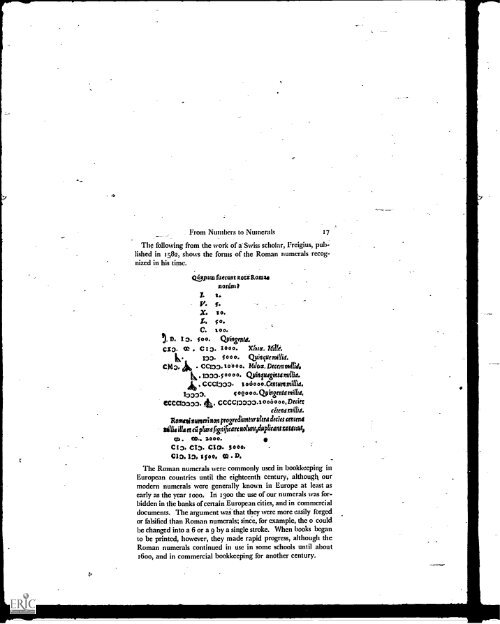ED077712
ED077712
ED077712
Create successful ePaper yourself
Turn your PDF publications into a flip-book with our unique Google optimized e-Paper software.
From Numbers to Numerals 17<br />
The following from the work of a-Swiss scholar, Frcigius, published<br />
in 1582, shows the forms of the Roman numerals recognized<br />
in his time.<br />
Qixpain rue rant Rots Romas<br />
norum?<br />
1.<br />
P. f.<br />
.<br />
X. s O.<br />
Z. 10.<br />
C. 100.<br />
1. D. 1 3. IOC. QPingell1d.<br />
CX 3. 4*.e C 1 3. 10 0 0. 'ale. Milk.<br />
t 133. C000. Quhtque millis.<br />
CM 0. D. I& cc133. lob e, e). Klotz. Deem<br />
L. 1333.f 0 0 0 0. Qpinquagints<br />
. CCC1333. t o 6o 0 o.Centum<br />
1337a.<br />
S00000.Qstitigentamillra,<br />
CCCCI3333.t000000,Deciet<br />
(items:Milts.<br />
ecca3330.<br />
numerinots progrediuntur ultra creeks (entail<br />
milGailiaetcaptoalignificareuotunt icluplicant notarair,<br />
W . co.. 2.000.<br />
ct3. c13. cur,. s000.<br />
c13.13, goo. co D.<br />
The Roman numerals were commonly used in bookkeeping in<br />
European countries until the eighteenth century, although our<br />
modern numerals were generally known in Europe at least as<br />
early as the year row. In 1300 the use of our numerals was forbidden<br />
in the banks of certain European cities, and in commercial<br />
documents. The argument was they were more easily forged<br />
or falsified than Roman numerals; since, for example, the o could<br />
be changed into a 6 or a 9 by a single stroke. When books began<br />
to be printed, however, they made rapid progress, although the<br />
Roman numerals continued in use in some schools until about<br />
1600, and in commercial bookkeeping for another century.





